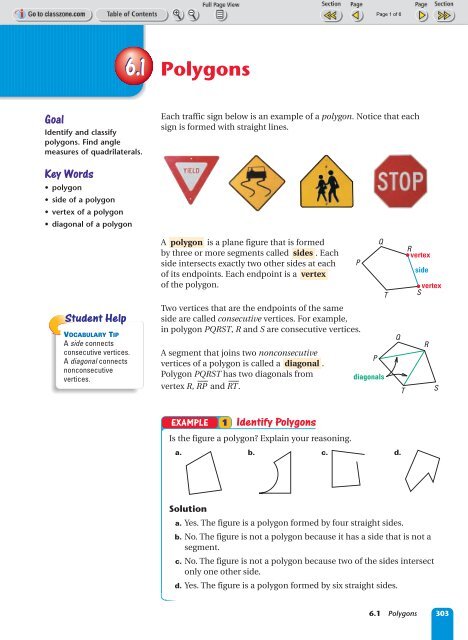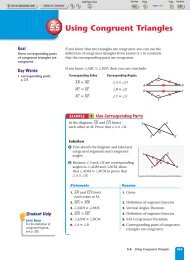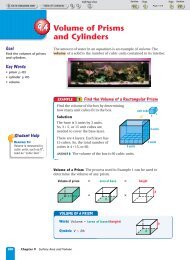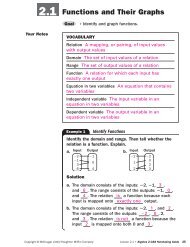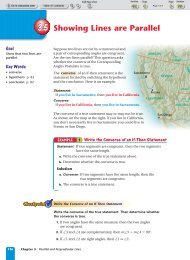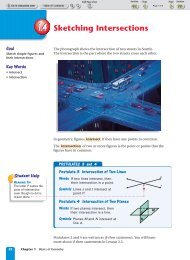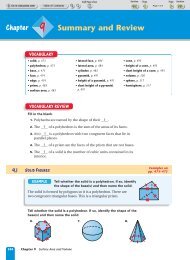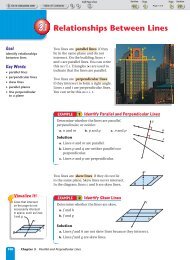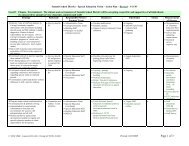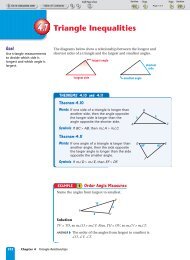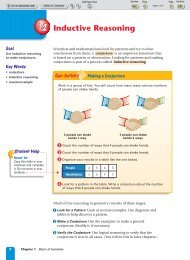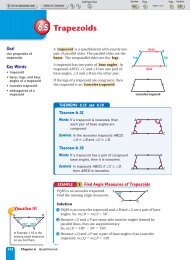6.1 Polygons
6.1 Polygons
6.1 Polygons
Create successful ePaper yourself
Turn your PDF publications into a flip-book with our unique Google optimized e-Paper software.
Goal<br />
Identify and classify<br />
polygons. Find angle<br />
measures of quadrilaterals.<br />
Key Words<br />
• polygon<br />
• side of a polygon<br />
• vertex of a polygon<br />
• diagonal of a polygon<br />
Student Help<br />
VOCABULARY TIP<br />
A side connects<br />
consecutive vertices.<br />
A diagonal connects<br />
nonconsecutive<br />
vertices.<br />
<strong>6.1</strong> <strong>Polygons</strong><br />
Each traffic sign below is an example of a polygon. Notice that each<br />
sign is formed with straight lines.<br />
A polygon is a plane figure that is formed<br />
by three or more segments called sides . Each<br />
side intersects exactly two other sides at each<br />
of its endpoints. Each endpoint is a vertex<br />
of the polygon.<br />
Two vertices that are the endpoints of the same<br />
side are called consecutive vertices. For example,<br />
in polygon PQRST, R and S are consecutive vertices.<br />
A segment that joins two nonconsecutive<br />
vertices of a polygon is called a diagonal .<br />
Polygon PQRST has two diagonals from<br />
vertex R, RP &* and RT&*.<br />
EXAMPLE 1 Identify <strong>Polygons</strong><br />
Is the figure a polygon? Explain your reasoning.<br />
a. b. c. d.<br />
Solution<br />
a. Yes. The figure is a polygon formed by four straight sides.<br />
b. No. The figure is not a polygon because it has a side that is not a<br />
segment.<br />
c. No. The figure is not a polygon because two of the sides intersect<br />
only one other side.<br />
d. Yes. The figure is a polygon formed by six straight sides.<br />
P<br />
P<br />
P<br />
diagonals<br />
T<br />
P<br />
T<br />
R<br />
vertex<br />
side<br />
vertex<br />
S<br />
R<br />
S<br />
<strong>6.1</strong> <strong>Polygons</strong> 303
Student Help<br />
STUDY TIP<br />
To classify a polygon<br />
not listed in the table,<br />
use the number of<br />
sides. For example, a<br />
polygon with 14<br />
sides is a 14-gon. A<br />
polygon with n sides<br />
is an n-gon.<br />
304 Chapter 6 Quadrilaterals<br />
Classifying <strong>Polygons</strong> You can classify polygons by the number of<br />
sides they have. Some special types of polygons are listed below.<br />
TYPES OF POLYGONS<br />
Triangle<br />
Quadrilateral<br />
Pentagon<br />
EXAMPLE 2 Classify <strong>Polygons</strong><br />
Decide whether the figure is a polygon. If so, tell what type. If not,<br />
explain why.<br />
a. b. c. d.<br />
Solution<br />
3 sides<br />
4 sides<br />
5 sides<br />
Hexagon<br />
Heptagon<br />
Octagon<br />
6 sides<br />
7 sides<br />
8 sides<br />
a. The figure is a polygon with four sides, so it is a quadrilateral.<br />
b. The figure is not a polygon because it has some sides that are not<br />
segments.<br />
c. The figure is a polygon with five sides, so it is a pentagon.<br />
d. The figure is not a polygon because some of the sides intersect more<br />
than two other sides.<br />
Identify and Classify <strong>Polygons</strong><br />
Decide whether the figure is a polygon. If so, tell what type. If not,<br />
explain why.<br />
1. 2. 3. 4.
Student Help<br />
STUDY TIP<br />
Name a polygon by<br />
listing its vertices<br />
consecutively in either<br />
direction. Two names<br />
for the quadrilateral in<br />
Example 3 are PQRS<br />
and RQPS.<br />
Quadrilaterals A diagonal of a quadrilateral divides it into two triangles,<br />
each with angle measures that add up to 180. So, the sum of the<br />
measures of the interior angles of a quadrilateral is 2 180, or 360.<br />
B<br />
2<br />
A<br />
1<br />
EXAMPLE 3 Find Angle Measures of Quadrilaterals<br />
Find the measure of aS.<br />
P<br />
80<br />
Solution<br />
P<br />
70<br />
70<br />
R<br />
S<br />
Use the fact that the sum of the measures of the interior angles<br />
of a quadrilateral is 360.<br />
maP maQ maR maS 360<br />
Quadrilateral Interior Angles<br />
Theorem<br />
708070maS 360 Substitute angle measures.<br />
220maS 360 Simplify.<br />
ANSWER The measure of aS is 140.<br />
Find Angle Measures of Quadrilaterals<br />
Find the measure of aA.<br />
6<br />
THEOREM <strong>6.1</strong><br />
3<br />
ma1 ma2 ma3 180<br />
B<br />
C 2<br />
C C<br />
3<br />
4<br />
4<br />
Quadrilateral Interior Angles Theorem<br />
5<br />
Words The sum of the measures of the interior<br />
angles of a quadrilateral is 360.<br />
Symbols ma1 ma2 ma3 ma4 360<br />
maS 140 Subtract 220 from each side.<br />
5. C 6. C<br />
7.<br />
B<br />
110<br />
60<br />
55<br />
A<br />
100<br />
D<br />
B<br />
80<br />
160<br />
D<br />
A<br />
D<br />
1<br />
A<br />
6 5<br />
A D<br />
ma4 ma5 ma6 180<br />
1<br />
B<br />
2<br />
72<br />
4<br />
108<br />
C<br />
108<br />
D<br />
A<br />
<strong>6.1</strong> <strong>Polygons</strong> 305<br />
3
<strong>6.1</strong><br />
Exercises<br />
Guided Practice<br />
Vocabulary Check<br />
306 Chapter 6 Quadrilaterals<br />
1. What type of polygon has 8 sides? 15 sides?<br />
2. Use the diagram of the pentagon<br />
shown at the right. Name all of<br />
the diagonals from vertex D.<br />
Is the figure a polygon? Explain your reasoning.<br />
3. 4. 5.<br />
Find the measure of aA.<br />
Practice and Applications<br />
Extra Practice<br />
See p. 685.<br />
Skill Check<br />
Homework Help<br />
Example 1: Exs. 8–10<br />
Example 2: Exs. 8–10,<br />
21, 24–27<br />
Example 3: Exs. 15–20,<br />
28<br />
6. A<br />
7.<br />
125<br />
B<br />
70<br />
60<br />
D C<br />
Classifying <strong>Polygons</strong> Decide whether the figure is a polygon. If so,<br />
tell what type. If not, explain why.<br />
8. 9. 10.<br />
11. Logical Reasoning What is the fewest number of sides a polygon<br />
can have? Explain your answer, then name the polygon.<br />
Visualize It!<br />
12. Two different pentagons<br />
Sketch the figure(s) described.<br />
13. A hexagon with three diagonals drawn from a single vertex<br />
14. A quadrilateral with two obtuse angles<br />
A<br />
A<br />
B<br />
B<br />
105<br />
E<br />
C<br />
D<br />
113<br />
75<br />
C<br />
D
IStudent Help<br />
I CLASSZONE.COM<br />
HOMEWORK HELP<br />
Extra help with problem<br />
solving in Exs. 18–20 is<br />
at classzone.com<br />
Plants<br />
CARAMBOLA, or star fruit,<br />
has a cross section shaped<br />
like a five-pointed star.<br />
Finding Angle Measures Find the measure of aA.<br />
15. A<br />
16. B<br />
17. D<br />
A 95<br />
D<br />
124<br />
110<br />
C<br />
55<br />
Using Algebra Find the value of x.<br />
18. 19. 20.<br />
65<br />
60<br />
80<br />
150<br />
110<br />
(x 30)<br />
B<br />
Parachutes Some gym classes play games using parachutes that look<br />
like the polygon below.<br />
21. Tell how many sides the polygon has<br />
and what type of polygon it is.<br />
22. Polygon LMNPQRST is one name for<br />
the polygon. State two other names<br />
using the vertices.<br />
23. Name all of the diagonals that have<br />
vertex M as an endpoint. Not all of the<br />
diagonals are shown.<br />
Plants Use the following information.<br />
Cross sections of roots and stems often resemble polygons. Next to<br />
each cross section is the polygon it resembles. Tell how many sides<br />
each polygon has and tell what type of polygon it is.<br />
Source: The History and Folklore of North American Wildflowers<br />
24. Virginia Snakeroot 25. Caraway<br />
26. Fennel 27. Poison Hemlock<br />
D<br />
87 63<br />
3x<br />
C<br />
T<br />
S<br />
C 100<br />
100<br />
2x<br />
84<br />
L M<br />
R<br />
P<br />
95<br />
B<br />
2x<br />
N<br />
P<br />
A<br />
<strong>6.1</strong> <strong>Polygons</strong> 307
Standardized Test<br />
Practice<br />
Mixed Review<br />
Algebra Skills<br />
308 Chapter 6 Quadrilaterals<br />
28. Technology Use geometry<br />
software to draw a quadrilateral.<br />
Measure each interior angle and<br />
calculate the sum. What happens<br />
to the sum as you drag the<br />
vertices of the quadrilateral?<br />
29. Multi-Step Problem Envelope manufacturers fold a speciallyshaped<br />
piece of paper to make an envelope, as shown below.<br />
●1<br />
a. How many sides are formed by the outer edges of the paper<br />
before it is folded? Name the type of polygon.<br />
b. Tell how many sides are formed by the outer edges of the paper<br />
in Steps 2–4. Name the type of polygon formed after each step.<br />
c. If the four angles of the red quadrilateral in Step 4 are<br />
congruent, then what is the measure of each angle?<br />
Line Relationships Determine whether the lines are parallel,<br />
perpendicular, or neither. (Lesson 3.1)<br />
30. AB ^&*( and CE ^&*( 31. AC ^&*( and BE ^&*(<br />
32. AB ^&*( and AC ^&*( 33. AC ^&*( and CE ^&*(<br />
Finding Angle Measures Find the measure of the numbered angle.<br />
(Lesson 3.4)<br />
34. 35. 36.<br />
2<br />
108<br />
1<br />
●2 ●3 ●4<br />
Distributive Property Use the distributive property to rewrite the<br />
expression without parentheses. (Skills Review, p. 671)<br />
37. 4(x 3) 38. (x 1)6 39. 2(x 7)<br />
40. 5(2x 3) 41. 3(5x 2) 42. (4x 4)x<br />
72<br />
D<br />
A<br />
A<br />
C<br />
3<br />
B<br />
B<br />
C<br />
E<br />
97


